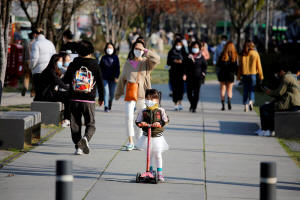Breakthrough infections may be less contagious; vaccine protection wanes
faster in cancer patients
 Send a link to a friend
Send a link to a friend
 [May 27, 2022] By
Nancy Lapid [May 27, 2022] By
Nancy Lapid
(Reuters) - The following is a summary of
some recent studies on COVID-19. They include research that warrants
further study to corroborate the findings and that has yet to be
certified by peer review.
Breakthrough infections may be less contagious
Fully vaccinated individuals who get infected with the coronavirus
spread the infection to fewer people and are contagious for less time
compared to people who are partially vaccinated or unvaccinated, a small
study from South Korea suggests.
In 173 hospital workers with COVID-19, including 50 who had breakthrough
infections, researchers found that the virus had been transmitted to
others in the hospital by 7% of the vaccinated group compared with 26%
of the unvaccinated, even though the two groups had similar viral loads
when diagnosed. In a separate group of 45 people with mild COVID-19 who
were being quarantined, the researchers observed shedding of infectious
virus particles for four days in the six people who had been fully
vaccinated, 8 days in the 11 partially vaccinated people, and 10 days in
the 28 unvaccinated people.

"Data from this study provide important evidence that despite the
possibility of breakthrough infections, COVID-19 vaccinations remain
critically useful for controlling the spread of SARS-CoV-2," the
researchers said.
Vaccine protection wanes faster for cancer patients
COVID-19 vaccines are effective in most cancer patients, but less so
than in the general population and the efficacy wanes more quickly,
according to a large study.
When the Delta variant of the coronavirus was predominant in the UK,
researchers tracked 377,194 individuals with cancer and more than 28
million people without malignancies. After two doses of a COVID-19
vaccine from Pfizer/BioNTech or AstraZeneca, overall vaccine
effectiveness against infection was 69.8% in the general population and
only slightly lower, at 65.5%, for cancer patients, the researchers
reported on Monday in The Lancet Oncology. Three-to-six months later,
however, vaccine effectiveness was 61.4% in the general population but
had dropped to 47% in the cancer group. The vaccines were 83.3%
effective against COVID-related hospitalization and 93.4% effective
against death for cancer patients, but this protection also waned within
three-to-six months, the researchers said. Vaccine effectiveness was
lowest and waned most quickly in people with lymphoma or leukemia. In
cancer patients who had received chemotherapy or radiotherapy in the
past 12 months, vaccine effectiveness was lower and waned faster than in
cancer patients who did not receive treatments within the past year.
[to top of second column]
|

A girl wearing a protective face mask to prevent contracting the
coronavirus disease (COVID-19) rides a toy kick scooter at a park in
Seoul, South Korea, April 3, 2020. REUTERS/Heo Ran

"This study... highlights the importance of
vaccination booster programs and rapid access to COVID-19 treatments
for people undergoing cancer treatments," study leader Peter Johnson
of the University of Southampton said in a statement.
MRI technique may yield clues to long COVID breathlessness
In people with lasting breathlessness after COVID-19, a special type
of magnetic resonance imaging (MRI) reveals lung abnormalities that
traditional imaging techniques do not detect, a small study shows.
In 23 patients with shortness of breath lasting for months after
COVID-19, including 11 who had not required hospitalization, the
researchers performed hyperpolarized xenon 129MRI, or Hp-XeMRI, to
look for abnormalities in gas exchange - the way oxygen and carbon
dioxide move between the lungs and the blood. All participants had
normal or near normal CT scans and lung function tests, but in both
groups, Hp-XeMRI showed abnormalities in gas transfer, the research
team reported on Tuesday in Radiology. They cannot explain the
abnormalities, and they do not know for sure yet whether the
abnormalities are actually contributing to patients' symptoms. But
shortness of breath is among the most common symptoms reported by
people with long COVID, and the researchers hope the findings in
this small study will be a clue to the cause.
"Using Hp-XeMRI may enable us to further understand the cause of
breathlessness in long COVID patients, and ultimately lead to better
treatments to improve this often debilitating symptom," study
co-author James Grist from the University of Oxford said in a
statement.
(Reporting by Nancy Lapid; Editing by Bill Berkrot)
[© 2022 Thomson Reuters. All rights
reserved.]
This material may not be published,
broadcast, rewritten or redistributed.
Thompson Reuters is solely responsible for this content.
 |